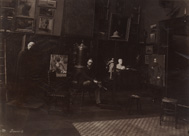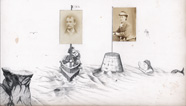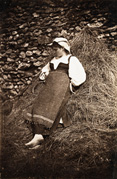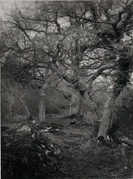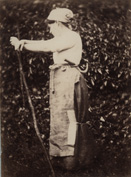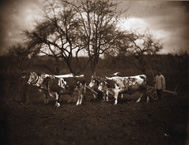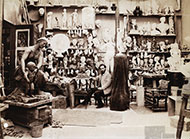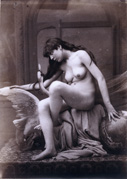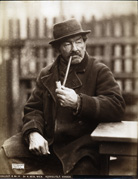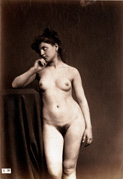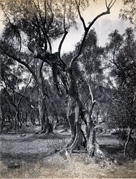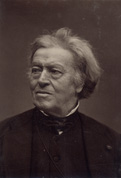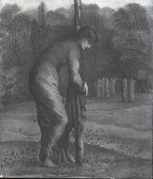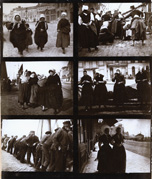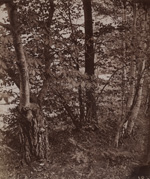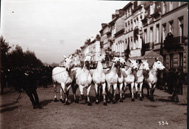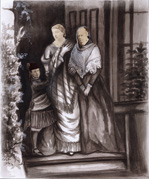Albert Pierre Dawant (1852-1923) in his Parisian studio
Albumen print, c. 1890s
10/10; 204 x 278 mm, unmounted
$1350.
Albumen print, c. 1890s
10/10; 204 x 278 mm, unmounted
$1350.
Cupid
Albumen print & watercolour or pen & ink, 1880s
Tonality 6/10 & 7/10, minor foxing. Tiny piece of corner missing on mount; 260 x 452 mm., photocollage
$1500.
For an excellent overview of photocollage, see Elizabeth Siegel's 'Playing with Pictures. The Art of Victorian Photocollage', 2009, based on the exhibition at the Art Institute of Chicago.
Albumen print & watercolour or pen & ink, 1880s
Tonality 6/10 & 7/10, minor foxing. Tiny piece of corner missing on mount; 260 x 452 mm., photocollage
$1500.
For an excellent overview of photocollage, see Elizabeth Siegel's 'Playing with Pictures. The Art of Victorian Photocollage', 2009, based on the exhibition at the Art Institute of Chicago.
Door of house in Frascati
Albumen print, 1870s
Tonality 7/10, some edge fading; 260 x 198mm., unmounted
$1500.
The print has G.E. Chauffourier's distinctive numbering ('506 Frascati') in the negative. Chauffourier took over Simelli's studio and printed from his negatives as well as those of A. De Bonis. See the study by Lundberg & Pinto, 2007 (details in Bibliography section), for more information on this remarkable school of unorthodox 'artist's study' photographers whose work prefigured that of Atget by 25 years.
Albumen print, 1870s
Tonality 7/10, some edge fading; 260 x 198mm., unmounted
$1500.
The print has G.E. Chauffourier's distinctive numbering ('506 Frascati') in the negative. Chauffourier took over Simelli's studio and printed from his negatives as well as those of A. De Bonis. See the study by Lundberg & Pinto, 2007 (details in Bibliography section), for more information on this remarkable school of unorthodox 'artist's study' photographers whose work prefigured that of Atget by 25 years.
Field worker with sickle
Albumen print, 1870s
10/10; 164 x 110, on Giraudon's' printed mount
$3750.
Auguste Giraudon commissioned these studies from an artist who produced this series "in his leisure time", probably near Barbizon. This is one of the few sets of studies in the early history of photography to be a close emulation of Millet's paintings of field workers, which Van Gogh so revered that he copied them endlessly. The photograph series appears to have been short-lived in terms of publishing. None were found in the Giraudon archives nor were they listed in his period catalogues of various works for sale. Few Giraudon's Artist photographs were acquired by institutions in the 19th century and the work remained largely unknown until a very few groups of these images emerged during the past 30 years.
Albumen print, 1870s
10/10; 164 x 110, on Giraudon's' printed mount
$3750.
Auguste Giraudon commissioned these studies from an artist who produced this series "in his leisure time", probably near Barbizon. This is one of the few sets of studies in the early history of photography to be a close emulation of Millet's paintings of field workers, which Van Gogh so revered that he copied them endlessly. The photograph series appears to have been short-lived in terms of publishing. None were found in the Giraudon archives nor were they listed in his period catalogues of various works for sale. Few Giraudon's Artist photographs were acquired by institutions in the 19th century and the work remained largely unknown until a very few groups of these images emerged during the past 30 years.
Forêt de Fontainebleau
Woodburytype, c. 1869
10/10; 186 x 137 mm, mounted on printed sheet.
$SOLD
Published in the Gazette des Beaux-Arts. Harrison was an Englishman located in Paris who also had a home in Barbizon and produced many photographs usable by artists. He exhibited some of these at the Société Française de Photographie. During part of the 1860s he was the Paris correspondent for the British Journal of Photography. An extremely beautiful example of a woodburytype print.
Woodburytype, c. 1869
10/10; 186 x 137 mm, mounted on printed sheet.
$SOLD
Published in the Gazette des Beaux-Arts. Harrison was an Englishman located in Paris who also had a home in Barbizon and produced many photographs usable by artists. He exhibited some of these at the Société Française de Photographie. During part of the 1860s he was the Paris correspondent for the British Journal of Photography. An extremely beautiful example of a woodburytype print.
Gleaner
Albumen print, 1870s
Tonality- 9/10; 172 x 125 mm., mounted on Giraudon mount with printed 'Étude d'Après Nature' logo
$2500.
Auguste Giraudon commissioned these studies from an artist who produced this series "in his leisure time", probably near Barbizon. This is one of the few sets of studies in the early history of photography to be a close emulation of Millet's paintings of field workers, which Van Gogh so revered that he copied them endlessly. The photograph series appears to have been short-lived in terms of publishing. None were found in the Giraudon archives nor were they listed in his period catalogues of various works for sale. Few Giraudon's Artist photographs were acquired by institutions in the 19th century and the work remained largely unknown until a very few groups of these images emerged during the past 30 years.
Albumen print, 1870s
Tonality- 9/10; 172 x 125 mm., mounted on Giraudon mount with printed 'Étude d'Après Nature' logo
$2500.
Auguste Giraudon commissioned these studies from an artist who produced this series "in his leisure time", probably near Barbizon. This is one of the few sets of studies in the early history of photography to be a close emulation of Millet's paintings of field workers, which Van Gogh so revered that he copied them endlessly. The photograph series appears to have been short-lived in terms of publishing. None were found in the Giraudon archives nor were they listed in his period catalogues of various works for sale. Few Giraudon's Artist photographs were acquired by institutions in the 19th century and the work remained largely unknown until a very few groups of these images emerged during the past 30 years.
Group of working oxen
Carbon print, 1860s
10/10; 285 x 377mm, mounted
$1350.
Adolphe Braun was a textile designer from Mulhouse who started his own studio in Dornach. In 1853, he turned to photography in order to 'put together a collection of studies for artists who used floral motifs' (see Naef & Marbot, 1980). Outdoor studies of animals for painters was one of many of Braun's 'themes'.
Carbon print, 1860s
10/10; 285 x 377mm, mounted
$1350.
Adolphe Braun was a textile designer from Mulhouse who started his own studio in Dornach. In 1853, he turned to photography in order to 'put together a collection of studies for artists who used floral motifs' (see Naef & Marbot, 1980). Outdoor studies of animals for painters was one of many of Braun's 'themes'.
Henri Honoré Plé (1853-1922), French sculptor in his Parisian studio
Albumen print, c. 1885s
Tonality- 7/10, some creases, some edge tears repaired on verso with non-archival tape; 205 x 276 mm., unmounted
$1000
Albumen print, c. 1885s
Tonality- 7/10, some creases, some edge tears repaired on verso with non-archival tape; 205 x 276 mm., unmounted
$1000
Il y avoit un géant vide 'Unawares'
Albumen print & watercolour or pen & ink, c. 1880s
7/10, minor foxing on paper; 280 x 224 mm
$SOLD
For an excellent overview of photocollage, see Elizabeth Siegel's 'Playing with Pictures. The Art of Victorian Photocollage', 2009, based on the exhibition at the Art Institute of Chicago.
Albumen print & watercolour or pen & ink, c. 1880s
7/10, minor foxing on paper; 280 x 224 mm
$SOLD
For an excellent overview of photocollage, see Elizabeth Siegel's 'Playing with Pictures. The Art of Victorian Photocollage', 2009, based on the exhibition at the Art Institute of Chicago.
Leda & the Swan
Albumen print, 1870s
Tonality- 9/10; 272 x 191 mm., mounted
$1750.
Nude photographs were beginning to be banned in France in the 1850s. As a result of this, photographers emerged some years later posing their models in exact replication of classical works of art. This was presumably to reassure the authorities that all the nude studies were académies intended for artists, rather than being pornography. Here Marconi re-enacts the Greek myth of Leda and the swan, used in paintings by artists over the ages, including Michelangelo and Leonardo. Marconi's nude studies are the most pronounced examples of using real life nudes to imitate works of art and today often represent a striking sense of the surreal.
Albumen print, 1870s
Tonality- 9/10; 272 x 191 mm., mounted
$1750.
Nude photographs were beginning to be banned in France in the 1850s. As a result of this, photographers emerged some years later posing their models in exact replication of classical works of art. This was presumably to reassure the authorities that all the nude studies were académies intended for artists, rather than being pornography. Here Marconi re-enacts the Greek myth of Leda and the swan, used in paintings by artists over the ages, including Michelangelo and Leonardo. Marconi's nude studies are the most pronounced examples of using real life nudes to imitate works of art and today often represent a striking sense of the surreal.
Man smoking pipe
Albumen print, 1870s
8-9/10; 219 x 169 mm, unmounted
$1000.
Dr. Heid, based in Vienna, made many studies for artist's use in the 19th century. Heid's logo is at bottom of print area in negative.
Albumen print, 1870s
8-9/10; 219 x 169 mm, unmounted
$1000.
Dr. Heid, based in Vienna, made many studies for artist's use in the 19th century. Heid's logo is at bottom of print area in negative.
Nude study
Albumen print, c. 1870s
9-10/10; 142 x 97 mm, unmounted
$650.
Located at 30 boulevard d'Enfer in Paris in the 1870's, Igout was the photographer of many 19th century academic nudes produced to aid artists, usually published in multiple image format (copy prints that are much smaller than the present example) by the editeur, Calavas. Though classical in composition, a fine use of lighting, props and posing makes these among the more attractive of the late 19th century nude studies.
Albumen print, c. 1870s
9-10/10; 142 x 97 mm, unmounted
$650.
Located at 30 boulevard d'Enfer in Paris in the 1870's, Igout was the photographer of many 19th century academic nudes produced to aid artists, usually published in multiple image format (copy prints that are much smaller than the present example) by the editeur, Calavas. Though classical in composition, a fine use of lighting, props and posing makes these among the more attractive of the late 19th century nude studies.
Olives trees near San Remo
Albumen print, c. 1870s
8-9/10; 224 x 172 mm, mounted
$475.
Little is known about Guidi but he made some quite 'modern' studies of plants in Northern Italy, possibly with artists principally in mind as potential clients. A small San Remo view and the partial remains of two others (cropped) on mount verso.
Albumen print, c. 1870s
8-9/10; 224 x 172 mm, mounted
$475.
Little is known about Guidi but he made some quite 'modern' studies of plants in Northern Italy, possibly with artists principally in mind as potential clients. A small San Remo view and the partial remains of two others (cropped) on mount verso.
Portrait of Jean Baptiste Camille Corot (1796-1875)
Woodburytype, 1870s
Tonality- 10/10; 120 x 82 mm., on Galerie Contemporaine mount, mount cut down.
$600.
Woodburytype, 1870s
Tonality- 10/10; 120 x 82 mm., on Galerie Contemporaine mount, mount cut down.
$600.
Princess Sabra tied to the tree by Edward Burne Jones
Platinum print, c. 1880s
10/10; 206 x 175 mm, unmounted
$675.
Hollyer was the consummate British photographer of artists' work in the 19th century. His platinum prints were sensitively used, as in this case, to present fine renderings after period drawings. Though collectors often eschew photographs of art work such images were coveted in the 19th century and deserve greater consideration today. Jones's original graphite and black chalk drawing is in the British Museum. There are two Hollyer rubber stamps on the verso as well as a pencil inscription – 'St. George & the Dragon 37. EBJ'.
Platinum print, c. 1880s
10/10; 206 x 175 mm, unmounted
$675.
Hollyer was the consummate British photographer of artists' work in the 19th century. His platinum prints were sensitively used, as in this case, to present fine renderings after period drawings. Though collectors often eschew photographs of art work such images were coveted in the 19th century and deserve greater consideration today. Jones's original graphite and black chalk drawing is in the British Museum. There are two Hollyer rubber stamps on the verso as well as a pencil inscription – 'St. George & the Dragon 37. EBJ'.
Six scenes of the Low Countries
Albumen print, c. 1900
10/10; 84 x 112 mm. (Approx. – printed on one sheet), mounted
$850.
A remarkable group of animated scenes taken with a camera capable of fast exposures, possibly studies for an artist.
Albumen print, c. 1900
10/10; 84 x 112 mm. (Approx. – printed on one sheet), mounted
$850.
A remarkable group of animated scenes taken with a camera capable of fast exposures, possibly studies for an artist.
Study of foliage
Albumen print, c. 1870
Tonality- 9/10; 190 x 159 mm., unmounted
$2200.
Kotzsch worked within only a very limited area near Loschwitz in Germany. He is the perfect example of an artist's study photographer whose concentration on highly objective studies of nature without artifice present a very modern vision to today's observer.
This image is illustrated in Chevrier et. al., 'August Kotzsch 1836-1910. Pioneer of German Photography', 1992, p. 25.
Albumen print, c. 1870
Tonality- 9/10; 190 x 159 mm., unmounted
$2200.
Kotzsch worked within only a very limited area near Loschwitz in Germany. He is the perfect example of an artist's study photographer whose concentration on highly objective studies of nature without artifice present a very modern vision to today's observer.
This image is illustrated in Chevrier et. al., 'August Kotzsch 1836-1910. Pioneer of German Photography', 1992, p. 25.
Team of horses
Gelatin silver print, c. 1890s
10/10, corner tear; 113 x 159 mm, unmounted
$575.
An artist's study photograph from the collection of the painter, José Maria Sert.
Gelatin silver print, c. 1890s
10/10, corner tear; 113 x 159 mm, unmounted
$575.
An artist's study photograph from the collection of the painter, José Maria Sert.
Three generations, photomontage
Albumen print, 1880s
7-8/10; 298 x 246mm
$SOLD
For an excellent overview of photocollage, see Elizabeth Siegel's 'Playing with Pictures. The Art of Victorian Photocollage', 2009, based on the exhibition at the Art Institute of Chicago.
Albumen print, 1880s
7-8/10; 298 x 246mm
$SOLD
For an excellent overview of photocollage, see Elizabeth Siegel's 'Playing with Pictures. The Art of Victorian Photocollage', 2009, based on the exhibition at the Art Institute of Chicago.

